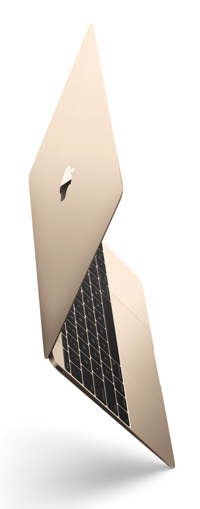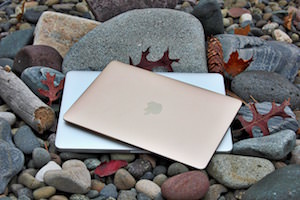With the introduction of its new ultraportable laptop — the MacBook — Apple reengineered the future of its notebook line but also introduced a new and difficult question: Should I get a MacBook or MacBook Air?
Don’t worry, this is the kind of question I get asked all the time. And the answer? It depends far less on the tech specs and far more on how you want to use your new MacBook or MacBook Air.
First, let’s talk about the core elements and differences between the MacBook Air and the new MacBook.
Both notebook models are light and portable and capable of handling web, email, writing, social media, and work tasks. Neither will excel at graphically intense action games, but both will let you edit home or social media video with ease. Basically, if you have common computing needs, both the MacBook or MacBook Air will likely work great for you.
That said, what are the key differences between the MacBook and MacBook Air? I’ll answer them with a series of questions — about what you might want — and recommend the right MacBook for you.
Do You Want a ‘Retina’ Screen?

The MacBook adds a splash of color as an option.
The key to the new MacBook is the super-sharp Retina display. The MacBook Air has an excellent display, but its individual pixels of light are not packed as densely together as they are in the Retina display. What does this mean? A Retina display makes text and images appear sharper and clearer. Most people won’t notice much difference with photos during casual use, but most people can tell a difference with text — the text shown on a Retina display is sharper and clearer, making it slightly more readable and pleasant.
Generally, if you can afford a Mac with a Retina display, I recommend that you get a Mac with a Retina display simple because the overall visual experience will be stepped up a notch.
However, what if a few hundred dollars is important to your budget? Should your stretch toward a MacBook with Retina display or error toward an entry-level priced MacBook Air?
Don’t despair here — you should know that, basically for the last four years, the MacBook Air has been the laptop to beat. Lots of hard-core tech journalists have made the MacBook Air their go-to notebook . . . and they spent hours upon hours on the MacBook Air working with text. Just because Apple introduced a new MacBook doesn’t mean the MacBook Air is any less suitable for most people.
MacBook vs MacBook Air: Portability Over Power?
The new Apple MacBook weighs just 2 pounds and is only a half-inch thick at its thickest point — 13.1 millimeters. It 11 inches wide and, when closed, is just 7.74 inches deep. It’s remarkably similar in size to the 11-inch MacBook Air, which weighs in at just 2.38 pounds and is two-thirds of an inch thick at its thickest point (17 mm). If you’re looking for an ultraportable comparison, the 11-inch MacBook Air isn’t going to feel much heavier than the new MacBook. Noticeable? Sure. But it’s not like your back is going to hurt carrying it around. The key difference is that the 12-inch MacBook has a larger, sharper screen packed into its lid.

Surprisingly, the new 11-inch and 13-inch MacBook Air for 2015 boast faster processors than the new MacBook.
The 13-inch MacBook Air is just 2.96 pounds and 17 mm thick at its thickest point. It’s just 12.8 inches wide and 8.94 inches deep. What’s this mean? It’s pretty damn portable, too.
Still, if you want the lightest form factor possible, the new MacBook is your choice. It’s wickedly small and light.
As for power, though, the MacBook is widely expected to offer less computing horsepower than either MacBook Air. How? Why?
The new MacBook uses a dual-core Intel Core M processor, which is a new processor that consumes less energy and produces less heat. It takes up less space and does not require a fan to keep it cool. The tradeoff? It has less computing power than the Intel Core i5 processors that are in the new MacBook Air models updated in early 2015.
For most people, this won’t be a big deal, but if you’re a heavy multi-tasker who works long hours and runs with dozens of web pages, email, and other applications open at the same time, you may appreciate the extra horsepower in the MacBook Air. (Still, if you have “horsepower” performance concerns, consider the 13-inch MacBook Pro, which is a little bigger in size than the 13-inch MacBook Air but more powerful at about the same price as a regular new MacBook.)
Are You Ready to Leap to USB-C?
What’s USB-C, you ask? The new Apple MacBook now has only one port — that’s right, just one port, and it’s used for charging and everything else. USB-C is a new computing standard that lets you connect displays, external storage, and power to a computer. It’s pretty cool, for sure, but it also means that if you want to connect a good USB-based external hard drive or thumb drive to your new MacBook, you will need to buy an adapter. Eventually, you’ll start seeing USB-C hard drives, thumb drives, and displays . . . but in the short term, you’ll need adapters or will pay a premium for the first USB-C peripherals to hit the market.
As for ease of use, USB-C cuts both ways on your desktop — one port is cool, but you may end up with a hub on your desktop in order to stay versatile.
If you don’t need to connect much to your MacBook, USB-C is a great solution. If you do have a lot to connect — existing external displays or perfectly good older hard drives — expect some extra costs to figure out all your connections.
Do You Want to Split Hairs Over MacBook Tech Specs?
There are three key tech specs and features that might give you pause.
Memory. The new 12-inch MacBook comes with 8GB of memory while the 11-inch and 13-inch MacBook Air come with 4GB of memory. Is 8GB better? In this situation it’s not necessarily better because the 12-inch MacBook has to drive a Retina display (which takes more resources than standard displays) and its processor isn’t as fast as the one in the MacBook Air. So, the real-world feel of “snappy” performance will likely seem better on the MacBook Air (but most people won’t notice a difference anyway).
Storage. The new entry-level 12-inch MacBook comes standard with 256GB of storage while the 11-inch and 13-inch MacBook Air come with 128GB of storage. Of course, you can get the 256GB versions of the MacBook Airs . . . and still spend less than the base price of the MacBook . . . but if you need more storage, this could be a point that can tip you toward a shiny new MacBook. [Learn More: Is 128GB Enough Storage?]
Force Touch. In order to make the 12-inch MacBook with Retina display so thin, Apple had to redesign its trackpad so that it would not physically hinge and move when you press down on it to click. Instead of mechanical movement, Apple created its new Force Touch trackpad that uses vibration to create a sensation of movement for a click. Early reports note that the new Force Touch trackpad feels nearly indistinguishable from Apple’s regular trackpad — and maybe even better because the top portion of a traditional trackpad doesn’t “click” because that’s where the hinge is. The top of a Force Touch trackpad will “click” for you, though. Where it gets interesting is the use of a Force Click gesture — if you press down harder than normal, you can do things like make a movie fast forward faster, launch a definition for a word, or bring up a map. Some apps in the future might utilize the Force Touch trackpad in interesting ways, but for now, it’s more of a gimmick than a deal maker. (But if you aren’t sold on the MacBook but are intrigued by the Force Touch trackpad and the potential for haptic (vibration) feedback in the future, consider the new 13-inch MacBook Pro because Apple added the new trackpad to the 2015 models.)
As for other tech specs, like battery life — you’ll get 9 hours with the 12-inch MacBook with Retina display, 9 hours with the 11-inch MacBook Air, and 12 hours with the 13-inch MacBook Air. And all of these notebooks will power 4K displays in case you want to attach an ultra-sharp external display.
Are You on a Tight Budget?
The new 12-inch MacBook with 8GB of memory and 256GB of storage will retail for about $1,299 while the slightly faster 512GB model will go for a whopping $1,599. It’s a tiny, ultra-portable wonder machine . . . but it’s not a great deal if you’re on a budget. If you end up needing adapters for displays or storage, your price just goes up.
The 11-inch MacBook Air starts at $899 for 128GB of storage and just $1,099 for $256GB. The 13-inch MacBook Air starts at $999 for 128GB of storage and $1,199 for 256GB. If you have common computing needs — and aren’t swayed by the Space Gray or Gold color options on the new MacBook — the MacBook Air is your best buy in the battle of the ultralight Apple notebooks.
If you’re willing to pack just a little more weight and size, the newly updated 3.48-pound 13-inch MacBook Pro with Retina display offers the best overall bang for your Apple computing dollar. It has a larger Retina screen as well as the new Force Touch trackpad . . . and it has a more powerful 2.7 GHz Intel Core i5 processor. Plus, it now has a 10-hour battery life.
MacBook vs MacBook Air vs MacBook Pro Recommendations
In some ways, the decision between buying a new MacBook can be summed up metaphorically in relation to garden tools. Consider this idea:
If the new 12-inch MacBook with Retina display is a shiny stainless steel bucket, the MacBook Air is a galvanized bucket. Both will do similar jobs and last a long time, but stainless steel is prettier and costs more. And what about the 13-inch MacBook Pro with Retina display? Well, that would be a wheelbarrow. And the 15-inch MacBook Pro? A bigger wheelbarrow. So now you know — MacBooks compared to common garden tools.
Meanwhile, if you’re not metaphorically inclined, try these recommendations:
- Get the new MacBook for the sweet Retina display in the ultraportable form factor.
- Choose any MacBook Air if you’re on a tight budget, appreciate a little better computing performance, and want more flexibility with ports.
- Opt for a 13-inch MacBook Pro with Retina display if you want a Retina-based notebook but need more computing performance than what the 12-inch MacBook offers.
Get the Gear and Check Pricing:
- 12-inch MacBook with Retina display
- 11-inch MacBook Air
- 13-inch MacBook Air
- 13-inch MacBook Pro with Retina display








